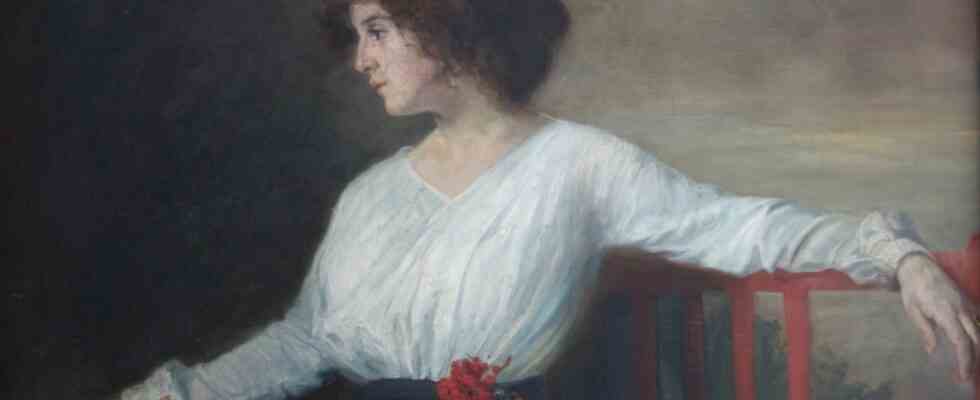If you read the old chronicles how energetic and self-confident the women’s movement was already more than a century ago, it is very surprising how long it took until the demands for equal rights were finally realized. One of the driving forces at the time was Marie Haushofer, who was born in Munich in 1871 and earned her living as a painter. She also appeared as a poet. Even before 1900 she was involved in the bourgeois women’s movement in Bavaria and in the Munich Association for Women’s Interests. The latter played a major role in the bourgeois women’s movement gaining a foothold in Bavaria.
It is obvious that the name Marie Haushofer plays a major role in the current exhibition in the gallery in the old town hall in Prien. Under the auspicious title “Glanzvoll”, the show takes a look back at the “good old days” already evoked in Georg Lohmeier’s “Königlich Bayerisches Amtsgericht” (Royal Bavarian District Court), as the period of the Prince Regent, which lasted from 1886 to 1912, is often glorified.
Undoubtedly it was a period of peace, when culture flourished, and yet there were dark sides that darkened this era. Massive political and social tensions cannot be denied, nor can the fact that women were no longer satisfied with their supporting role and rebelled. Thomas Mann already saw these years as marked by ambivalence, despite their splendor: on the one hand the end of time and on the other hand a breathless awakening.
At that time, Munich was a radiant metropolis in which new artistic trends pointed the way to modernity. In the exhibition it is easy to understand how painting moved away from traditional genre and history painting and risked a freer use of forms and colors under the influence of French Impressionism.
This development was particularly noticeable in landscape painting. Ingrid Fricke and Ute Gladigau, the curators of the Prien show, chose pictures that are not only beautiful to look at, but also explicitly address the role of women. Which brings us back to Marie Haushofer, the granddaughter of the well-known Chiemsee painter Max Haushofer, whose paintings provided important impetus for artistic freedom and the development of women. In addition to her works, 130 top-class loans from museums and private collections are on display, including oil paintings, watercolours, sculptures and photographs.
Leo Putz, On the Shore, painted 1909 (Siegfried Unterberger Collection).
(Photo: Walter Bayer/Jakob Tappeiner)
Leo Putz, Morning Sun, painted 1907 (Siegfried Unterberger Collection).
(Photo: Walter Bayer/Jakob Tappeiner)
Painters like the “Island Kings” Karl Raupp and Josef Wopfner, known for their Chiemsee landscapes, gave the women’s movement a boost. The picture of a woman reading a newspaper that cannot be overlooked on the tour comes from Raupp. Marie Haushofer’s grandfather, the already mentioned landscape painter Max Haushofer, founded one of the oldest European artists’ colonies on Fraueninsel in 1828. This was followed in the second half of the 19th century by numerous other artists who settled around Lake Chiemsee. They included Christian Maximilian Baer on Fraueninsel, Leo Putz in Hartmannsberg, Julius Exter in Übersee and Ludwig von Zumbusch in Aiterbach. Famous guests kept coming by, such as Max Slevogt, Edward Cucuel, Wilhelm Leibl and of course Prince Regent Luitpold, who enjoyed swimming in Lake Chiemsee every summer. His appearances in Prien were always celebrated events.
Max Slevogt, Nachen am Chiemsee, painted 1900.
(Photo: Axel Brachat/GDKE Rhineland-Palatinate)
Julius Exter, Bathers on the Chiemsee beach, around 1925.
(Photo: Maria Scherf/Andrea Gruber/Bavarian Administration of State Palaces, Gardens and Lakes)
The private painting schools around the Chiemsee also offered many artists training opportunities that were still denied them at the academies. The exhibition not only shows how the development of modernity in art and the artistic freedom and development of women in the “good old days” radiated to the Chiemsee, but also received important impulses from here.
Accompanying the exhibition, the state historian Manfred Treml will give a lecture this Thursday that will shed more light on the epoch of the Prince Regent period and explain how the myth of the “good old days” was able to develop. He contrasts the usual glorification with the political reality of the time. Despite all the progress, a lot was missed at that time, says Treml, which of course die-hard monarchists don’t like to hear.
A lecture by the historian Werner K. Blessing will follow on May 12th. He speaks about “Bavarian society around 1900: continuity and upheaval”. The art historian Ruth Negendanck will conclude the series on May 31 with the lecture “Encounters. The Chiemsee Artist Landscape in the Prince Regent Period”. The lectures start at 7 p.m. Registration at [email protected].
The “Glanzvoll” exhibition runs until June 19th. On May 8th and 22nd as well as on June 5th and 19th, a guided tour by the curators will be offered at 2 p.m. During the exhibition, the gallery in the Old Town Hall is open on Thursday from 5 p.m. to 7 p.m. and from Friday to Sunday from 2 p.m. to 5 p.m. The entrance is at Alte Rathausstrasse 22.

